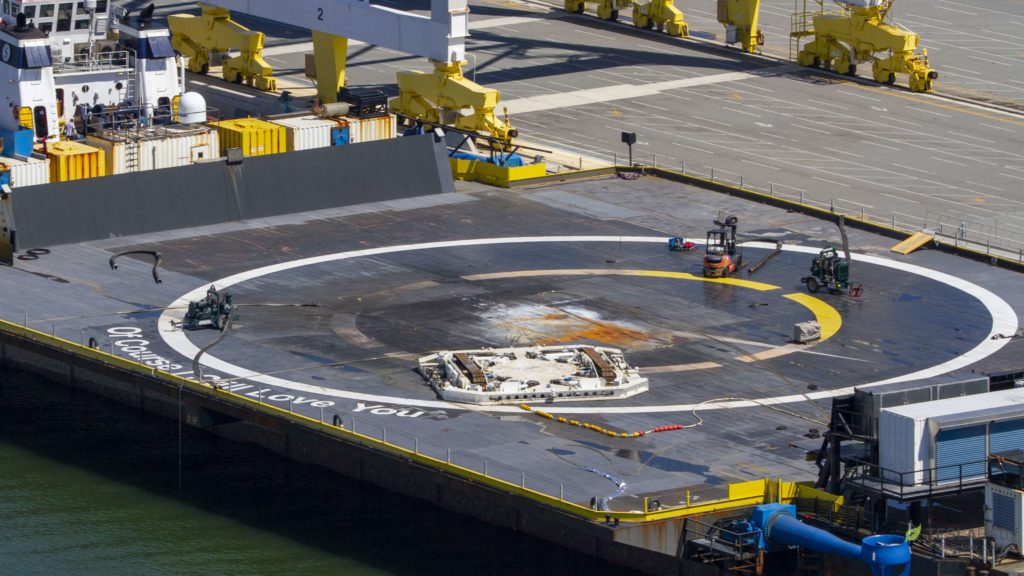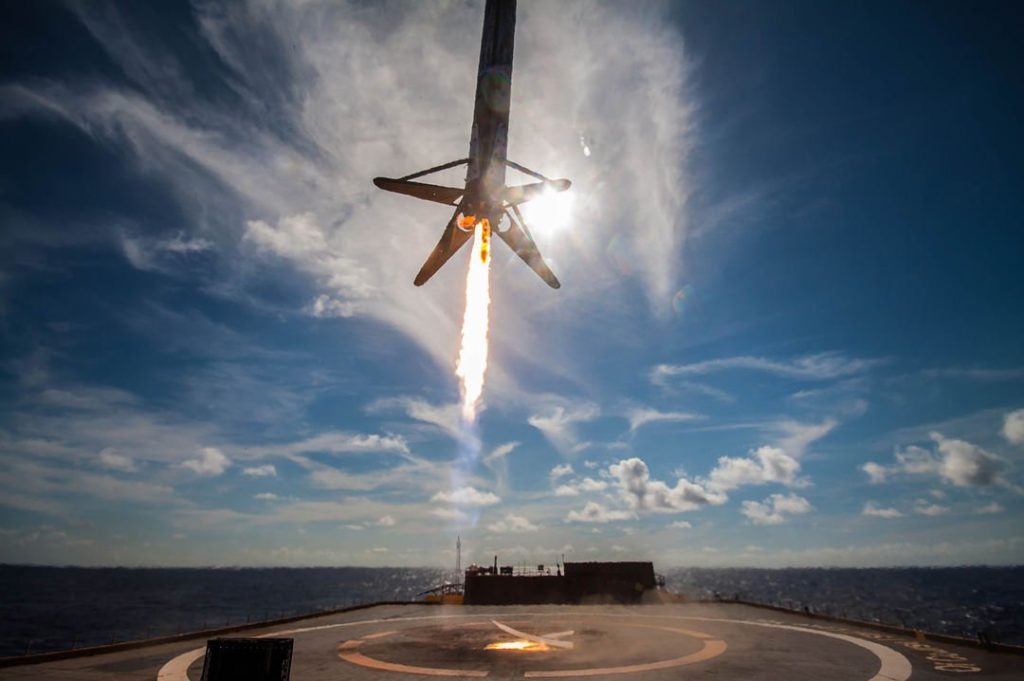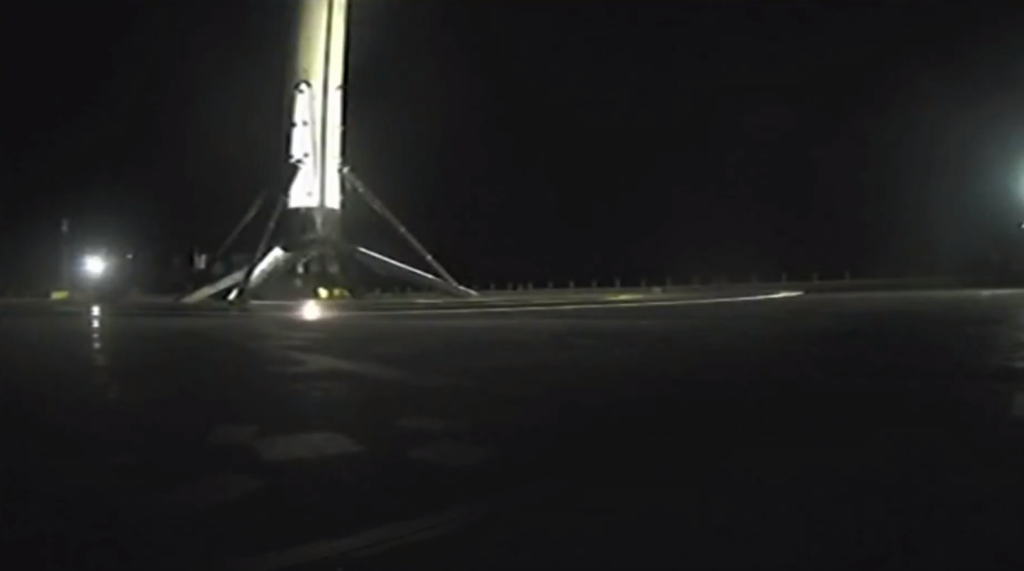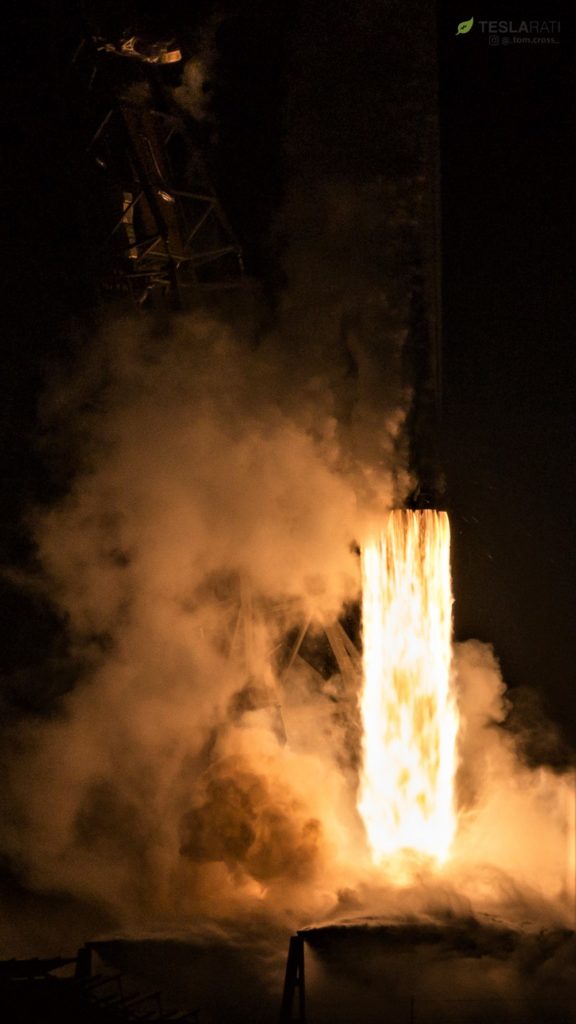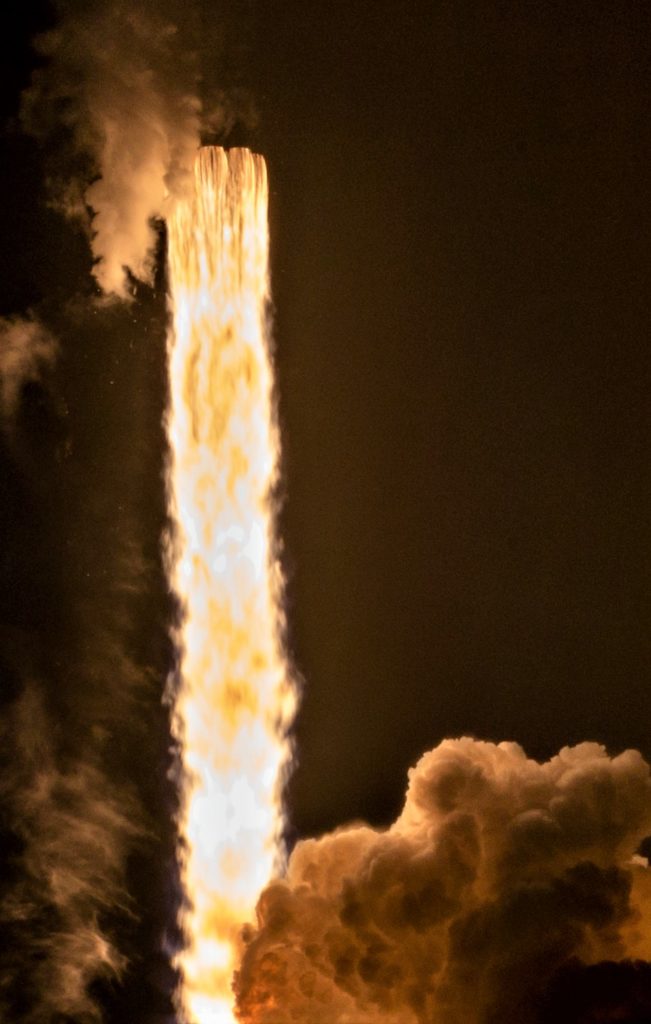
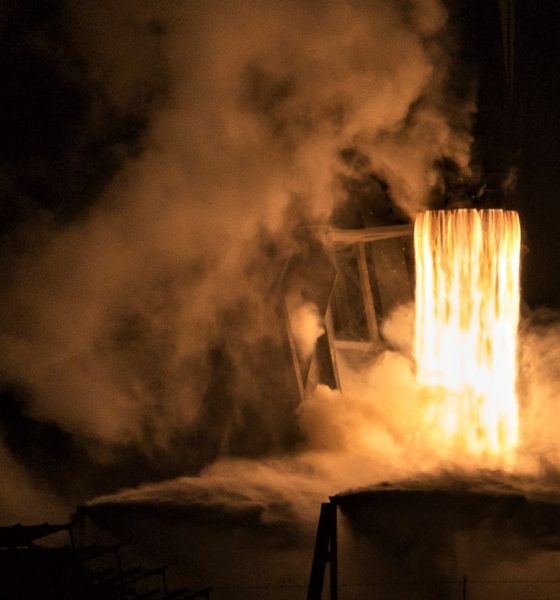
News
SpaceX’s Falcon 9 launches atop pillar of flame and races home on drone ship
After yet another gorgeous and successful night launch and drone ship recovery of SpaceX’s Falcon 9 rocket, Of Course I Still Love You and its Block 5 booster passenger have wasted no time at all in a bid to avoid the brunt of Hurricane Florence, currently nipping at the heels of SpaceX’s East Coast recovery fleet.
Last night’s launch of Telstar 18 VANTAGE marked Falcon 9’s 60th successful mission. pic.twitter.com/iKXsnayASz
— SpaceX (@SpaceX) September 10, 2018
While Florence is now firmly aimed at Virginia and the Carolinas and is at least 24 hours out from actually impacting Falcon 9, its drone ship carrier, and the tugboat towing them back to Port Canaveral, the trio are certainly skirting the edge of the storm in the sense that hurricanes and tropical storms are known to sometimes drastically depart from their forecasted trajectories.
In the case of drone ship OCISLY and Falcon 9 B1049, tugboat Hawk is only capable of safely pulling the duo at around 7 knots (~8 mph), whereas Hurricane Florence is now heading West at a stately 13 mph, likely to accelerate moderately as the storm picks up energy. Ultimately, it’s probably of minor concern to SpaceX, but very little time was nevertheless wasted securing the recovered rocket booster (presumably with a robotic tool known informally as Octagrabber) and reaching a healthy cruising speed scarcely six or seven hours after its post-launch landing.
- SpaceX’s rocket-securing robot, known as Octagrabber, seen on OCISLY after another successful rocket recovery, August 12th. (Tom Cross)
- Falcon 9 B1046 seen landing on OCISLY for the first time, May 2018. (SpaceX)
- B1046 lands on drone ship Of Course I Still Love You for the second time in three months, August 2018. (SpaceX)
- B1049 stands proud after a successful landing aboard drone ship OCISLY. (SpaceX)
With a bit more than 75 miles under its belt half a day after landing, Falcon 9 should crest the horizon East of Port Canaveral as early as Wednesday morning, giving SpaceX technicians maybe 24 hours to attempt to secure the rocket and/or transport it to a hurricane-rated building in the unlikely but possible event that Florence veers South towards Cape Canaveral over the next two days. The risk is undoubtedly quite low, but it’s hard to rationalize not taking all practical precautions when a $30-40 million piece of potentially reusable rocket hardware is set to bear the brunt of any failure on the contrary.
- Falcon 9 B1049 lifts off from SpaceX’s LC-40 pad on September 10, producing more than 1.7 million pounds of thrust.(Tom Cross)
- Falcon 9 B1049 lifts off from SpaceX’s LC-40 pad, September 10. (Tom Cross)
Nevertheless, this stunning launch – SpaceX’s 60th successful Falcon 9 mission and 16th successful rocket launch this year alone – has served as another impressive indication of just how mature a launch vehicle Falcon 9 Block 5 is, marking its fifth wholly uneventful mission – in this case threading the needle through downright bad weather conditions at the launch site and an approaching tempest in the Atlantic.
Captured on liftoff by Teslarati photographer Tom Cross, the successful launch of Telstar 18V will hopefully become the first of many successful missions for the highly reusable Block 5 booster, B1049.
For prompt updates, on-the-ground perspectives, and unique glimpses of SpaceX’s rocket recovery fleet check out our brand new LaunchPad and LandingZone newsletters!

News
Tesla starts showing how FSD will change lives in Europe
Local officials tested the system on narrow country roads and were impressed by FSD’s smooth, human-like driving, with some calling the service a game-changer for everyday life in areas that are far from urban centers.

Tesla has launched Europe’s first public shuttle service using Full Self-Driving (Supervised) in the rural Eifelkreis Bitburg-Prüm region of Germany, demonstrating how the technology can restore independence and mobility for people who struggle with limited transport options.
Local officials tested the system on narrow country roads and were impressed by FSD’s smooth, human-like driving, with some calling the service a game-changer for everyday life in areas that are far from urban centers.
Officials see real impact on rural residents
Arzfeld Mayor Johannes Kuhl and District Administrator Andreas Kruppert personally tested the Tesla shuttle service. This allowed them to see just how well FSD navigated winding lanes and rural roads confidently. Kruppert said, “Autonomous driving sounds like science fiction to many, but we simply see here that it works totally well in rural regions too.” Kuhl, for his part, also noted that FSD “feels like a very experienced driver.”
The pilot complements the area’s “Citizen Bus” program, which provides on-demand rides for elderly residents who can no longer drive themselves. Tesla Europe shared a video of a demonstration of the service, highlighting how FSD gives people their freedom back, even in places where public transport is not as prevalent.
What the Ministry for Economic Affairs and Transport says
Rhineland-Palatinate’s Minister Daniela Schmitt supported the project, praising the collaboration that made this “first of its kind in Europe” possible. As per the ministry, the rural rollout for the service shows FSD’s potential beyond major cities, and it delivers tangible benefits like grocery runs, doctor visits, and social connections for isolated residents.
“Reliable and flexible mobility is especially vital in rural areas. With the launch of a shuttle service using self-driving vehicles (FSD supervised) by Tesla in the Eifelkreis Bitburg-Prüm, an innovative pilot project is now getting underway that complements local community bus services. It is the first project of its kind in Europe.
“The result is a real gain for rural mobility: greater accessibility, more flexibility and tangible benefits for everyday life. A strong signal for innovation, cooperation and future-oriented mobility beyond urban centers,” the ministry wrote in a LinkedIn post.
News
Tesla China quietly posts Robotaxi-related job listing
Tesla China is currently seeking a Low Voltage Electrical Engineer to work on circuit board design for the company’s autonomous vehicles.

Tesla has posted a new job listing in Shanghai explicitly tied to its Robotaxi program, fueling speculation that the company is preparing to launch its dedicated autonomous ride-hailing service in China.
As noted in the listing, Tesla China is currently seeking a Low Voltage Electrical Engineer to work on circuit board design for the company’s autonomous vehicles.
Robotaxi-specific role
The listing, which was shared on social media platform X by industry watcher @tslaming, suggested that Tesla China is looking to fill the role urgently. The job listing itself specifically mentions that the person hired for the role will be working on the Low Voltage Hardware team, which would design the circuit boards that would serve as the nervous system of the Robotaxi.
Key tasks for the role, as indicated in the job listing, include collaboration with PCB layout, firmware, mechanical, program management, and validation teams, among other responsibilities. The role is based in Shanghai.
China Robotaxi launch
China represents a massive potential market for robotaxis, with its dense urban centers and supportive policies in select cities. Tesla has limited permission to roll out FSD in the country, though despite this, its vehicles have been hailed as among the best in the market when it comes to autonomous features. So far, at least, it appears that China supports Tesla’s FSD and Robotaxi rollout.
This was hinted at in November, when Tesla brought the Cybercab to the 8th China International Import Expo (CIIE) in Shanghai, marking the first time that the autonomous two-seater was brought to the Asia-Pacific region. The vehicle, despite not having a release date in China, received a significant amount of interest among the event’s attendees.
Elon Musk
Elon Musk and Tesla AI Director share insights after empty driver seat Robotaxi rides
The executives’ unoccupied tests hint at the rapid progress of Tesla’s unsupervised Robotaxi efforts.

Tesla CEO Elon Musk and AI Director Ashok Elluswamy celebrated Christmas Eve by sharing personal experiences with Robotaxi vehicles that had no safety monitor or occupant in the driver’s seat. Musk described the system’s “perfect driving” around Austin, while Elluswamy posted video from the back seat, calling it “an amazing experience.”
The executives’ unoccupied tests hint at the rapid progress of Tesla’s unsupervised Robotaxi efforts.
Elon and Ashok’s firsthand Robotaxi insights
Prior to Musk and the Tesla AI Director’s posts, sightings of unmanned Teslas navigating public roads were widely shared on social media. One such vehicle was spotted in Austin, Texas, which Elon Musk acknowleged by stating that “Testing is underway with no occupants in the car.”
Based on his Christmas Eve post, Musk seemed to have tested an unmanned Tesla himself. “A Tesla with no safety monitor in the car and me sitting in the passenger seat took me all around Austin on Sunday with perfect driving,” Musk wrote in his post.
Elluswamy responded with a 2-minute video showing himself in the rear of an unmanned Tesla. The video featured the vehicle’s empty front seats, as well as its smooth handling through real-world traffic. He captioned his video with the words, “It’s an amazing experience!”
Towards Unsupervised operations
During an xAI Hackathon earlier this month, Elon Musk mentioned that Tesla owed be removing Safety Monitors from its Robotaxis in Austin in just three weeks. “Unsupervised is pretty much solved at this point. So there will be Tesla Robotaxis operating in Austin with no one in them. Not even anyone in the passenger seat in about three weeks,” he said. Musk echoed similar estimates at the 2025 Annual Shareholder Meeting and the Q3 2025 earnings call.
Considering the insights that were posted Musk and Elluswamy, it does appear that Tesla is working hard towards operating its Robotaxis with no safety monitors. This is quite impressive considering that the service was launched just earlier this year.
